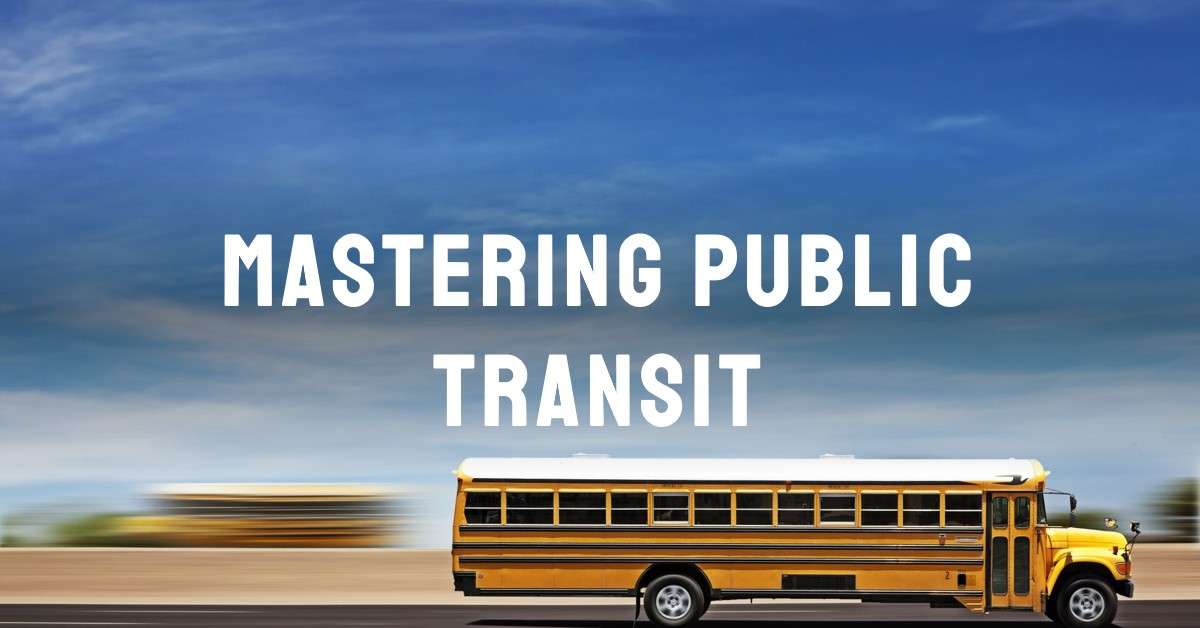How to Choose Transportation for Your Travels
Contents
- 1 How to Choose Transportation for Your Travels
- 1.1 Plan Around Peak Traffic Times
- 1.2 Checklist
- 1.3 Research Local Transportation Modes
- 1.4 Weigh Comfort Versus Price
- 1.5 Check for Group Travel Discounts
- 1.6 Account for Environmental Impact
- 1.7 Explore Car Rental Prospects
- 1.8 Understand Public Transit Systems
- 1.9 Consider Travel Time and Convenience
- 1.10 Evaluate Cost Efficiency of Options
- 1.11 Assess Your Destination’s Geography

Choosing the right transportation for your travels can greatly enhance your journey. Understanding key factors like accessibility, convenience, and local demographics is essential. By examining areas of interest such as commercial districts or health clinics on a map, you tailor routes that fit specific needs.
Ridership analysis helps match passenger demand to service supply efficiently while ensuring equitable access for all community members. This data-driven approach not only improves route effectiveness but also boosts passenger satisfaction by catering to varied travel requirements seamlessly.
Plan Around Peak Traffic Times

Plan around peak traffic times for a smoother travel experience. Scheduling trips during off-peak hours can save time and reduce stress. Use real-time data from the map to identify congested areas, commercial districts, schools, and health clinics that might affect your route.
By avoiding heavy traffic zones at busy times of day, you get to your destination faster. You also have a more pleasant journey.
How to Choose Transportation for Your Travels provides insights on optimizing routes using demographic data and ridership analysis features. It offers an efficient way to plan travels with minimal delays.
Checklist

Here’s a checklist to help you choose the right transportation for your travels.
– **Autos:** Ideal for family travel and bonding. Limits exposure to crowds.
– **Buses:** Budget-friendly and perfect for short trips worldwide. Often uncomfortable.
– **Cruise Ships:** Good value with lodging, meals, entertainment covered. Great for multiple destinations.
– **Ferries:** Essential in island regions of Asia, Europe, North America. Buy tickets early.
– **Rideshares (Lyft/Uber):** Convenient inner-city transport.
Uber is global while Lyft serves the USA and Canada only.
– **Planes:** Best suited for business or weekend getaways but expect possible delays due to air traffic or weather conditions
. Rvs are expensive rentals better fit outdoor adventures.
Research Local Transportation Modes

Check the local transportation modes available in your destination. Compare options like buses, trains, and taxis for cost and convenience. Ask locals or look online to find out how reliable these services are.
Examine schedules closely because some transport may not run late at night or on weekends. For road networks, consider if renting a car is practical based on traffic conditions and parking availability. Note that sea routes might be limited unless you’re near major ports; ships carry over 90% of global goods but aren’t commonly used by travelers.
Lastly, identify any specific rules such as driving licenses needed for car rentals or safety regulations when using public transit.
Weigh Comfort Versus Price

As you evaluate comfort versus price, consider your travel needs and budget. For instance, bus services like Northwest BUS offer excellent benefits such as accessibility, punctuality, and sustainability at affordable rates. When I’m on a tight budget but still want reliable transport across major locations in Saudi Arabia, this service is ideal.
Comfort can vary with different options. Luxury buses may cost more due to added amenities like Wi-Fi or extra legroom.
Check for Group Travel Discounts

When traveling in groups, seeking discounts is crucial. Many travel companies offer group rates that can save significant money—up to 30% off regular prices. Check with airlines like Desmo Travel for deals when booking more than ten tickets together.
Also consider train or bus services which often have lower fares for larger parties. Always ask about any special promotions or seasonal offers available. It never hurts to inquire directly either online or by phone, as some deals aren’t widely advertised.
Account for Environmental Impact

To lessen your environmental impact when choosing transportation, always opt for eco-friendly options. Use public transit systems like buses or trains that produce fewer emissions per passenger than cars do. Walking or biking not only reduces pollution but also immerses you in local culture.
If flying is necessary, book direct flights to minimize carbon emissions from take-offs and landings. Avoid rental cars if possible; instead, use ride-sharing services with low-emission vehicles. Choose accommodations that prioritize sustainability practices such as renewable energy usage and recycling programs.
These steps collectively make a significant difference in preserving the environment while traveling efficiently.
Explore Car Rental Prospects

When considering car rentals, I always look for loyalty programs like the National Emerald Club. This club allows me to bypass counters and choose any vehicle in their Emerald Aisle®. The convenience is unmatched; it saves time during hectic trips.
Additionally, using mobile apps from rental companies gives me control over my bookings on-the-go. According to a survey by National Car Rental, frequent business travelers highly value speed and choice in transportation options. From personal experience, having these perks makes renting cars not only practical but also enjoyable when traveling for work or leisure.
Understand Public Transit Systems

Understanding public transit systems is key to smooth travel. First, familiarize yourself with routes, timetables, and fare charts online to avoid confusion later. Knowing the difference between single-journey tickets and day passes can save you money.
Use navigation apps for real-time updates on delays or disruptions. Before traveling, research your destination’s transit system via official websites and forums for local insights. Learning basic phrases like “Where do I get off?” helps bridge language gaps.
Pre-booking tickets prevents long queues at stations while planning both primary routes and backups ensures seamless transitions even if unexpected issues arise.
Consider Travel Time and Convenience
When choosing travel transportation, consider both time and convenience. I often compare flight durations versus the flexibility of driving. For instance, flying may take a few hours but comes with strict schedules and packing constraints.
In contrast, road trips offer more freedom to stop en route for sights or breaks. Time zones also matter; long-haul flights can cause jet lag that eats into your vacation days. On shorter domestic routes costing $50 less than international ones like Rome vs Salt Lake City—saving time might outweigh cost savings.
Convenience extends to departure times: Avoiding 3 AM wake-up calls minimizes crankiness in family members enhancing overall trip satisfaction.
Evaluate Cost Efficiency of Options

To evaluate cost efficiency, list all transportation options available. Compare your budget with each option’s total costs. Consider fares, potential additional fees like luggage charges or seat reservations, and any discounts for booking in advance.
Fuel expenses include gas mileage if driving a rental car. Identify hidden expenses such as tolls or parking fees that might accumulate over time; they can substantially add to the original price. Finally, review user reviews about unexpected surcharges from different service providers so you don’t get caught off guard by extra payments at peak times when demand spikes unexpectedly due to unforeseen events beyond control of travelers themselves today.
Assess Your Destination’s Geography

Assessing your destination’s geography is crucial. I start by examining the layout and terrain of where I’m going. For mountainous areas, renting a sturdy vehicle might be necessary due to rough roads and steep climbs.
If my destination involves island hopping or coastal regions, ferries or boats are vital alternatives. I also look at urban versus rural characteristics; cities generally offer extensive public transport options like buses or subways while countryside areas may lack these conveniences making car rentals more suitable. Lastly, for places with adverse weather conditions such as snowstorms in winter months it’s imperative to ensure that any chosen transportation method can handle these challenges effectively.
Selecting the right transportation for your travels involves thoughtful consideration of various factors. I always start by evaluating my destination’s accessibility and available options like flights, trains, or car rentals. Time efficiency often plays a big role; shorter trips usually mean choosing faster means like planes or high-speed trains.
Comfort also matters—long journeys might require more comfortable accommodations within transport modes. Lastly, budget constraints guide my choices too—I weigh cost against convenience to find the best balance for each trip. For expert advice on travel plans visit Desmo Travel at https://www.desmotravel.com/.
Articles
References:
https://blog.optibus.com/transportation/5-transportation-planning-best-practices-to-help-you-plan-better-routes
https://access.seovendor.co/refsource?c=da60ded0f199648eb43bacce3042f0bf
https://weareprocarrier.com/news/article/modes-of-transport-logistics?refererSource=wearedg
https://hub.bnwtravel.com/post/tips-to-unlocking-group-travel-discounts-for-team-events
https://stateofmatterapparel.com/blogs/som-blog/sustainable-travel-how-to-travel-with-the-environment-in-mind
https://www.nationalcar.com/en/blog.html
https://www.vtpi.org/tranben.pdf
https://fastercapital.com/topics/choosing-the-ideal-destination.html

























